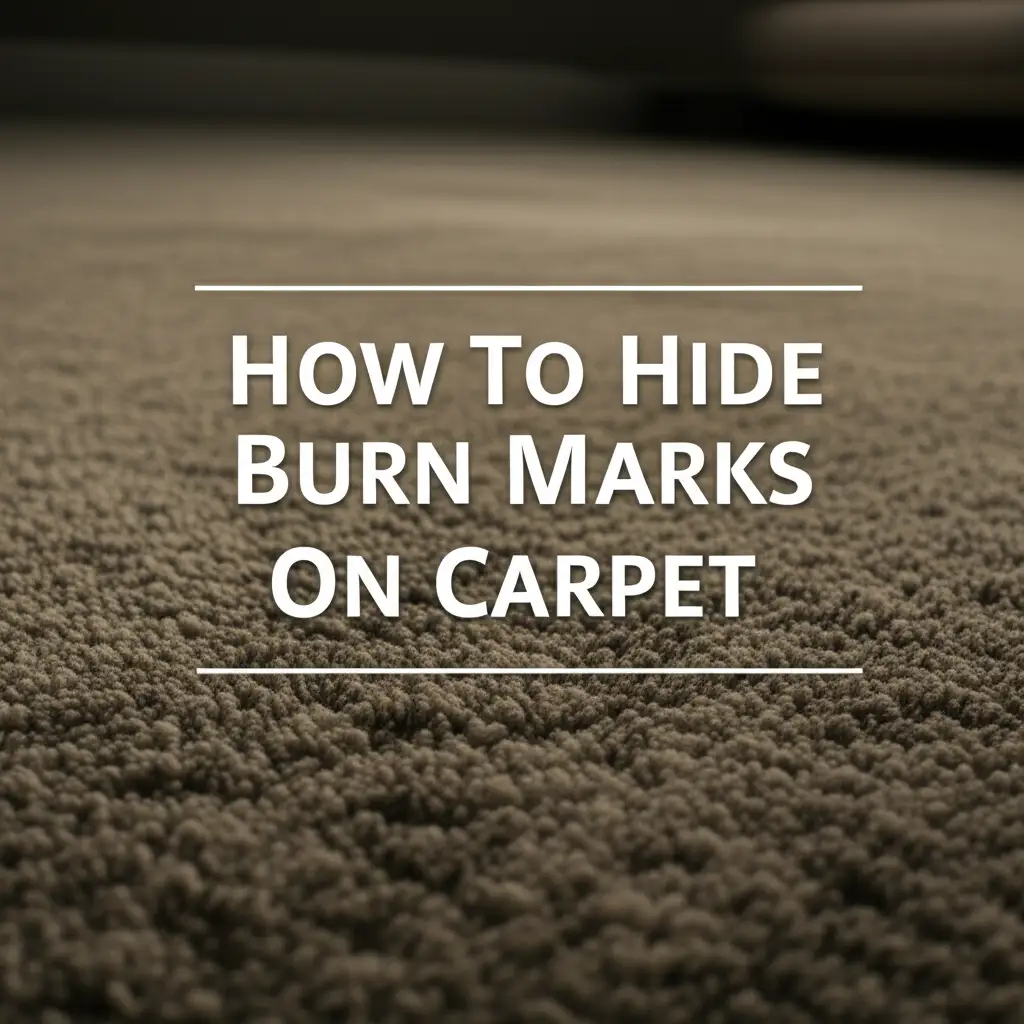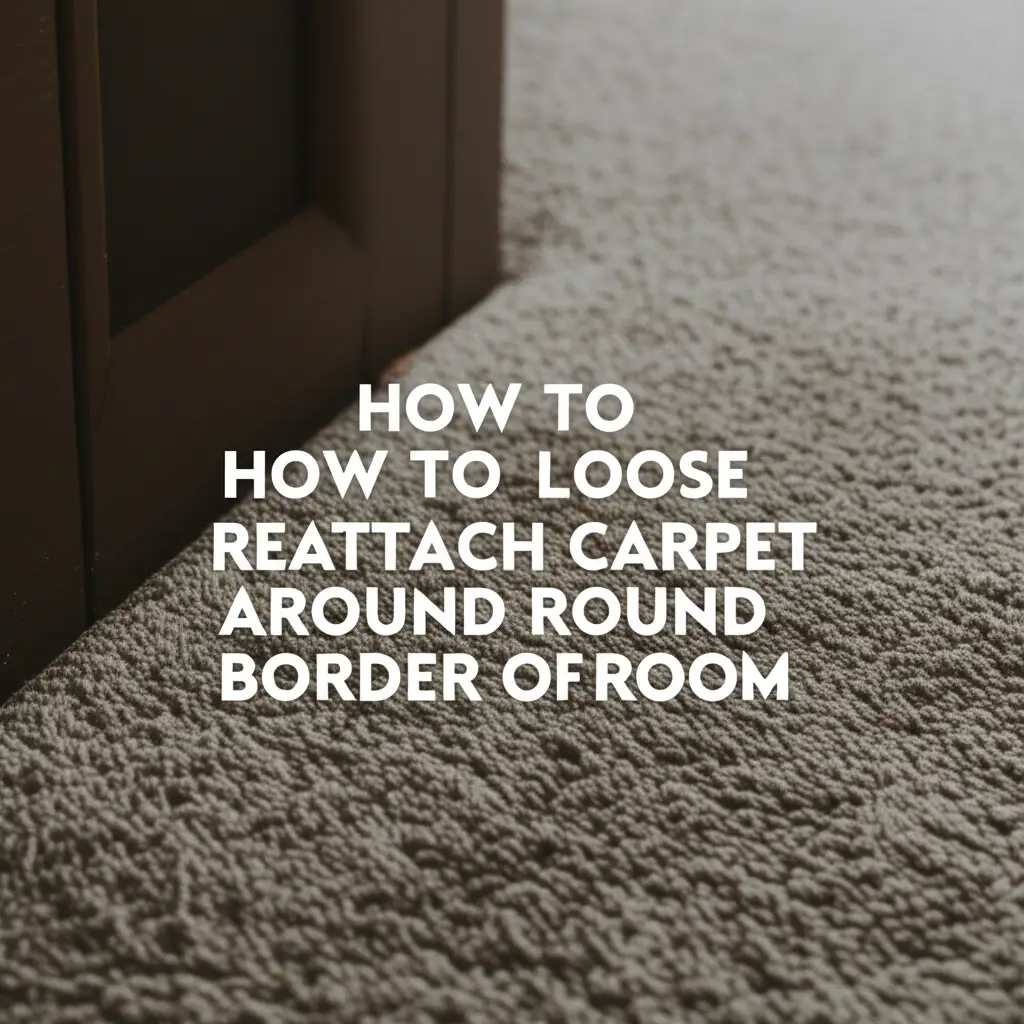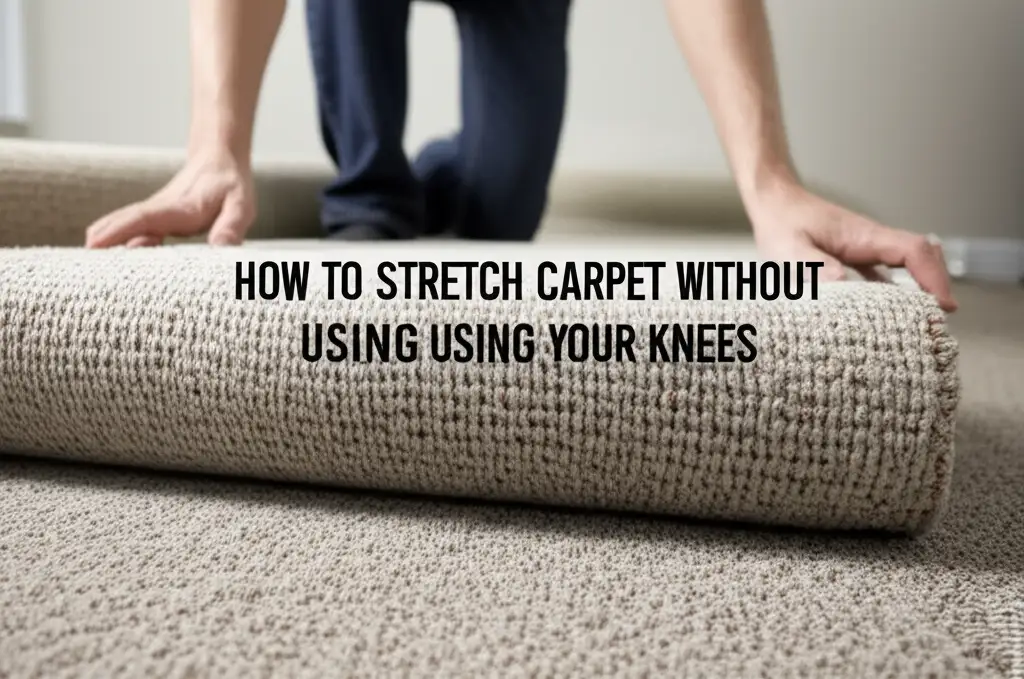· Tessa Winslow · Home Improvement · 13 min read
How To Hide Burn Marks On Carpet

Hide Burn Marks on Carpet: A Complete Guide
Accidents happen in any home. A dropped ember, a forgotten curling iron, or a lit candle falling over can leave an unwelcome burn mark on your carpet. These unsightly spots can feel permanent and ruin the look of a room. You might wonder if replacing the entire carpet is your only option. However, many effective ways exist to hide burn marks on carpet. I know the frustration of finding a damaged spot on my favorite rug. This guide offers practical solutions to make those burn marks disappear or become less noticeable. We will cover simple fixes, detailed repair methods, and clever camouflage techniques to restore your carpet’s beauty.
Takeaway
You can effectively minimize or hide carpet burn marks using several methods:
- Trim away singed fibers for minor burns.
- Patch the damaged area with a piece of matching carpet.
- Camouflage the mark with furniture or decorative elements.
- Seek professional help for extensive damage.
How do you hide a burn mark on carpet?
You can hide a burn mark on carpet by carefully trimming away singed fibers for small marks. For larger areas, you can cut out the damaged section and replace it with a matching piece of carpet. Strategic furniture placement or decorative rugs also offer effective camouflage.
Assessing the Damage: Light vs. Deep Carpet Burns
Before you begin any repair, you need to assess the burn mark. Not all burns are the same. Understanding the severity of the damage helps you choose the right repair method. A light burn affects only the tips of the carpet fibers. A deep burn goes through the fibers, often reaching the carpet backing.
Understanding Superficial Burns
A superficial burn mark on carpet looks like discolored or singed fibers. The carpet pile might feel stiff or crispy in the affected area. The backing of the carpet remains untouched. You can usually fix these light burns with simple tools. This type of damage is often caused by hot ash or a quick touch from a hot object. The fibers are still mostly intact, just scorched.
Identifying Deep Burns
A deep carpet burn shows a significant hole or melted patch. You might see the carpet backing or even the subfloor underneath. The fibers are completely destroyed in the affected spot. This damage usually results from sustained contact with a very hot object, like a hot iron or a dropped cigarette that burned for a longer time. Deep burns require more involved repair techniques. Ignoring deep burns can worsen the problem over time.
Minor Burn Fixes: Trimming and Blending Carpet Fibers
For minor carpet burns, you do not need to replace entire sections. Simple trimming and blending can make a big difference. This method works best for small, superficial burns. It is a good first step to try before more complex repairs.
Careful Trimming of Singed Fibers
Start by gathering your tools. You need a small, sharp pair of scissors, like nail scissors or embroidery scissors. Carefully inspect the burn mark. You will see fibers that are singed, discolored, or hardened. Gently snip off the very tips of these damaged fibers. Work slowly and precisely. Avoid cutting any healthy, undamaged fibers. My experience shows that taking your time here prevents making the problem worse.
Blending and Smoothing the Area
After trimming, use your fingers or a stiff brush to gently fluff up the surrounding carpet fibers. Push them over the trimmed area. This helps blend the repaired spot into the rest of the carpet. You want to make the transition as smooth as possible. Sometimes, a vacuum cleaner with a brush attachment can help lift the pile and further hide the mark. This method works well for small cigarette burns or hot ash spots. The goal is to make the damaged area less noticeable to the eye.
Patching Solutions: Seamless Carpet Repair
When a burn mark is too large or deep for simple trimming, patching is often the best solution. This involves replacing the damaged section with a new piece of carpet. The key to a seamless repair is finding a matching donor piece. This method offers a more permanent fix.
Utilizing a Donor Carpet Section
Finding a donor piece of carpet is crucial. Look for an inconspicuous area in your home where you can take a small piece. Common places include inside a closet, under a large piece of furniture, or from a leftover carpet remnant. If you have carpet tiles, this is much easier. You can simply replace the damaged tile. If your carpet is wall-to-wall, carefully cut a piece from a hidden area. Make sure the donor piece is slightly larger than the burn mark. This helps with alignment.
Once you have your donor piece, place it over the burn mark. Align the pattern or pile direction if your carpet has one. Use a sharp utility knife or carpet knife to cut through both the donor piece and the damaged carpet section underneath. This creates a perfectly sized hole and a perfectly sized patch. Remove the burnt carpet section. Apply carpet adhesive or double-sided carpet tape to the subfloor in the cutout area. Press the new patch firmly into place. Ensure the pile direction matches the surrounding carpet for a truly invisible repair. For detailed instructions on cutting and replacing sections, you might find this article on how to fix carpet in doorway helpful, as the cutting and securing principles are similar.
Exploring Carpet Repair Kits
Many commercial carpet repair kits are available. These kits often contain various tools and materials. They can include adhesive, cutting guides, and sometimes even fiber-matching tools. Some kits offer flocking fibers that you can blend with adhesive to fill small holes. These kits are generally user-friendly. They provide everything you need in one package.
When using a kit, follow the instructions carefully. Most kits involve cutting out the damaged area. You then insert a new piece or fill the hole with a fiber-adhesive mix. Some kits focus on melting new fibers into the existing ones. This can create a stronger bond. Consider the size and type of your burn when choosing a kit. A good quality kit can help you achieve a professional-looking repair. Understanding how to arrange carpet tiles can also give you ideas for using small, leftover pieces for patching.
Camouflage Techniques: Hiding Visible Marks
Sometimes, a full repair is not practical or desired. In these cases, clever camouflage can effectively hide burn marks. These methods are simple and often involve rearranging your existing home decor. They offer a quick and easy way to address the problem without extensive work.
Strategic Furniture Placement
One of the easiest ways to hide a carpet burn is to place furniture over it. This works well for marks located in high-traffic areas or central spots. Consider shifting a sofa, an armchair, or a coffee table slightly. A well-placed floor lamp or a decorative plant stand can also conceal smaller burns. Before moving heavy furniture, ensure you measure the burn mark’s size. This helps you select a piece of furniture that completely covers it. This solution is especially useful if the burn is in an area that doesn’t get much direct light.
Utilizing Rugs and Mats
Area rugs and decorative mats are excellent for covering larger or more noticeable burn marks. Choose a rug that complements your room’s decor and fits the space. Place the rug directly over the damaged area. This not only hides the burn but also adds style and warmth to your room. Runners are perfect for hallways with burn marks. Small doormats can hide burns near entryways. Ensure the rug is large enough to extend beyond the burn mark’s edges. This prevents the burn from peeking out.
Employing Strategic Decor Elements
Beyond furniture and rugs, other decor items can hide burns. A decorative basket, a large floor vase, or even a standing screen can serve this purpose. For very small burns, a carefully positioned magazine rack or a pet bed might do the trick. Think creatively about what you already own. Look for items that can naturally sit over the affected spot. This approach allows you to update your decor while also solving a practical problem. It’s a good way to give your room a fresh look without major expenses.
Professional Assistance: When to Call Experts for Carpet Repair
While many DIY methods exist to hide burn marks, some situations call for professional help. Knowing when to involve experts can save you time, effort, and potentially bigger headaches. Professionals have specialized tools and experience. They can often achieve results that are hard to replicate at home.
Large or Extensive Damage
If your carpet has a very large burn mark, or multiple extensive burns, DIY repair might be too challenging. A large area often requires significant cutting and patching. Achieving a seamless look across a wide expanse is difficult for an amateur. Professional carpet repair technicians deal with such damage regularly. They can assess the extent of the problem accurately. They also have access to larger pieces of matching carpet, if needed. For a deep burn that affects the subfloor, professional intervention might be necessary to ensure structural integrity and proper insulation. You might consider contacting a business carpet cleaner if you need help on a large scale. Services like how to get business carpet cleaner can guide you to finding suitable professionals.
Delicate or Expensive Carpets
Some carpets are more delicate or valuable than others. Antique rugs, handmade wool carpets, or carpets with intricate patterns require a gentle touch. Attempting DIY repairs on these materials can cause irreversible damage. A professional understands different carpet fibers and weaves. They know how to handle specific materials without causing further harm. They can match patterns and textures much more precisely. Investing in professional repair for a valuable carpet can preserve its longevity and appearance.
Seeking a Truly Seamless Finish
If you want the burn mark to disappear completely, a professional is your best bet. DIY patches, even when done carefully, can sometimes be visible upon close inspection. Professionals use specialized tools like power stretchers and seaming irons. These tools create truly invisible repairs. They also have techniques for blending fibers and ensuring the patch lies perfectly flat. If achieving a flawless finish is your top priority, especially in a prominent area of your home, professional help is highly recommended. For overall carpet care, understanding how carpet cleaning works can also highlight the precision professionals bring.
Prevention is Key: Protecting Your Carpet from Future Burns
The best way to deal with carpet burn marks is to prevent them from happening. Taking simple precautions can save you from future repair efforts and maintain your carpet’s pristine condition. A proactive approach is always better than a reactive one. I have learned this through experience.
Using Protective Barriers
Always use protective barriers when handling hot items. Place heat-resistant mats or trivets under hot pans or curling irons. If you use candles, make sure they are on stable, non-flammable surfaces. Use candle holders that catch wax drips and prevent direct contact with the carpet. For fireplaces, ensure a proper fire screen is in place to catch any stray embers. Ash can create small, yet damaging, burn marks. Even small items like a lit cigarette should always be extinguished in a proper ashtray.
Exercising Caution with Heat Sources
Be extra careful when using heat-generating appliances near carpeted areas. This includes hair dryers, straighteners, clothes irons, and portable heaters. Never leave these items unattended while hot. Always turn them off and allow them to cool down before placing them on or near carpet. If you must set down a hot appliance, place it on a hard, heat-resistant surface, like a tiled counter or a wooden board, not directly on the carpet. Simple habits can prevent costly damage.
Regular Maintenance and Awareness
Keeping your carpet clean can also help prevent small issues from becoming big problems. Regularly vacuuming removes debris that could hide small, smoldering items. Being aware of potential hazards in your home is also crucial. Do not place extension cords under rugs where they might overheat. Check electrical appliances for frayed wires. Simple vigilance goes a long way. If you face issues like deep grime, learning how to get deep grime out of carpet can help keep your carpet in top shape, making any burn more noticeable and easier to address before it worsens.
FAQ Section
Can a carpet burn be completely invisible after repair?
For small, superficial burns, careful trimming and blending can make the mark almost invisible. For larger patches, a professional repair can achieve a nearly seamless result, especially if a matching donor piece is used. DIY patches might be noticeable upon very close inspection.
What tools do I need for a DIY carpet patch?
For a basic carpet patch, you will need a sharp utility knife or carpet knife, a ruler, double-sided carpet tape or carpet adhesive, and a donor piece of carpet. Some people also use a blunt object or roller to press the patch firmly into place.
How do I find a matching piece of carpet for patching?
Look for a hidden area in your home, like inside a closet, under a large appliance, or in a rarely seen corner. You can also use a leftover remnant from the original installation. The goal is to find a piece that matches your carpet’s color, pile, and pattern.
Can I repair a burn mark on a rented carpet?
Yes, you can attempt to hide or repair a burn mark on rented carpet. However, it is often best to consult with your landlord or property management first. They might have specific repair guidelines or prefer professional intervention. DIY repairs, if done poorly, could result in charges.
Is it better to hide or repair a carpet burn mark?
This depends on the severity of the burn and your personal preference. Hiding is quicker and easier for minor marks or temporary solutions. Repairing offers a more permanent fix for significant damage. For deep burns, a proper repair is usually necessary for the longevity of the carpet.
What if I don’t have a donor piece of carpet?
If you lack a donor piece, you might try a carpet repair kit that uses flocking fibers to fill small holes. For larger burns, finding a very close color match from a carpet store or a professional repair service might be your only option. They sometimes have small remnants for such repairs.
Conclusion
Finding a burn mark on your carpet can feel like a setback. However, as we have explored, you have many effective ways to address this common household problem. Whether you choose a simple trim for a minor singe or undertake a full patch repair, restoring your carpet’s appearance is often achievable. Remember to assess the damage carefully before deciding on a method. From clever camouflage techniques using furniture and rugs to precise patching methods, you can make those unsightly marks disappear. For extensive damage or high-value carpets, do not hesitate to seek professional help. Prevention remains the most effective strategy. By taking simple precautions, you can protect your carpet from future burns. Now, you possess the knowledge to confidently hide burn marks on carpet and keep your home looking its best.





